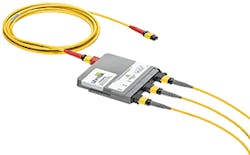Network Infrastructure Trends for 2019
5 Key Developments in Enterprise and Data Center Network Infrastructure —
What are the biggest developments in data center networks? How does the growth of PoE and wireless networks affect enterprise cabling installations? Here are some of the biggest infrastructure trends for the coming year.
TREND 1
The Power Over Ethernet Revolution Rolls On
This is a big year for Power over Ethernet (PoE). This system for delivering power and data over twisted pair cabling is about to get a big boost from the late 2018 release of the IEEE 802.3bt standard, defining PoE over 4 pairs instead of 2. This change means PoE will be able to support more devices that require higher power. For this reason — along with the rise of the Internet of Things (IoT) — more than 700 million PoE-enabled Ethernet switch ports and 280 million PoE devices are expected to ship in the next 5 years, according to market research firm Dell’Oro Group (http://www.delloro.com).
PoE now encompasses a tremendous range of devices and applications, and the drive for more connected Intelligent Buildings is increasingly feasible thanks to PoE. One of the biggest pushes is for more Smart Lighting, and Gartner research (http://www.gartner.com) predicts that 70% of new commercial building lighting installations will implement Smart Lighting by 2020.
The power requirements vary between powered devices. PoE for VoIP, clocks, HVAC, and indoor cameras, will typically require lower power: under 30 watts. PoE to wireless access points (WAPs), lighting, and outdoor security cameras with a heating element that will require power over 30 watts.
These higher power systems will need the right cabling and network design in place. Twisted-pair cabling transmitting upwards of 100 watts can encounter potential overheating issues that may affect transmission performance. Industry standards groups like Telecom Industry Association (TIA, https://www.tiaonline.org) recommend Category 6A cable for new PoE installations in order to meet high-wattage PoE requirements and support future network upgrades.
TREND 2
Planning for Next-Generation Enterprise Wireless
Much has been made in the news about the coming 5G cellular upgrades and their impact on wireless networks. There is no doubt that 5G will bring big benefits for certain applications.
However, deployments of 5G will be slow, and limited to dense urban areas in the near future. These deployments require significant capital expenditures to install all the 5G electronics, which means 5G won’t get installed unless there can be a return on that investment. In the enterprise, it will be costly to retrofit devices such as laptops, printers, security cameras, and projectors, with 5G chipsets. Plus, enterprise buildings will require in-building antenna systems, increasing deployment cost.
Enterprise Wi-Fi will continue to evolve to bring many (if not more) benefits over 5G. IEEE 802.11ax — also known as Wi-Fi 6 — due for release in 2019. It will allow for wireless data rates up to 10 Gb/s and wider coverage than 802.11ac. In 2019, we will also see 802.11ax show up in all kinds of devices, including phones, computers, tablets, and more.
InvisiLight® Solution for Deploying Fiber
April 2, 2022Go to Market Faster. Speed up Network Deployment
April 2, 2022Episode 10: Fiber Optic Closure Specs Explained…
April 1, 2022Food for Thought from Our 2022 ICT Visionaries
April 1, 2022At the same time, 802.11ac (Wi-Fi 5) will continue to grow in the enterprise, with the capability to deliver up to 6.9 Gb/s. To get the most out of 802.11ac and 802.11ax, the TIA recommends using Cat 6A cables in new installations, which will give you higher data rates and increased power. The organization also suggests a minimum of 2 drops for every wireless WAP, so future upgrades take less time.
TREND 3
AV and IT Systems Converge
Businesses, universities, and other enterprise environments, are increasingly integrating their AV systems into the larger network. With videoconferencing, presentation through BYOD devices, collaborative technology, and large 4K displays, IT and AV are more intertwined than ever. And that means that AV will increasingly fall under the realm of IT managers, as opposed to facility managers in the past.
We will continue to see a move to HDBaseT technology throughout these enterprise environments, especially in classrooms and conference rooms. HDBaseT allows for the long-distance delivery of ultra-high-definition audio and video, Ethernet, controls, USB 2.0 and power — all over twisted pair category cable. Power over HDBaseT (PoH) powers the HDBaseT link over the same category cable, allowing for integrated transmitters, in devices like matrix switches to power remote receivers.
TREND 4
Data Centers Move to 100 Gb/s and Beyond
Data centers everywhere are updating their networks to address bandwidth demands. 100 Gb/s Ethernet made big moves in the market in 2018, and 100 Gb/s switch shipments are now surpassing 40 Gb/s shipments. Cloud provider HyperScalers (https://www.hyperscalers.com), and large enterprise data center networks are moving to 100 Gb/s uplinks and 25 Gb/s at the server. 25 Gb/s port shipments grew 359% year-over-year in early 2018, according to IDC’s Worldwide Quarterly Ethernet Switch and Router Tracker (https://www.idc.com). The jump is attributed to top-of-rack updates in dense data center server access ports.
In the future, we can also expect these networks to migrate to 200 and 400 Gb/s uplinks and 50 and 100 Gb/s at the server. 400 Gb/s Ethernet switches began shipping in 2018, and we will begin to see adoption among some large and hyperscale data centers in 2019. Crehan Research (http://www.crehanresearch.com/) predicts that these switches will drive the majority of data center switch bandwidth by 2022. According to Crehan Research’s Data Center Switch Long-Range Forecast Report, 400 Gb/s will surpass a million ports shipped in less time than it took 100 Gb/s to reach that threshold.
As the market moves toward 200 and 400 Gb/s, single-mode fiber cabling will see greater adoption. This is a result of decreasing cost and recent standards committee activities that continue to promote more single-mode options. The decrease in cost is largely the result of large hyperscale data centers installing more lower cost single-mode transceivers, and as a result reshaping the enterprise and data center markets. Adoption by these companies has reduced the cost of single-mode optics to the point where the cost for 100 Gb/s single-mode transceivers dropped tenfold over the past 2 years, bringing it in line with multimode fiber.
Leviton has seen this trend with its own customers. In 2018, we surveyed network professionals about the type of fiber they would install today to plan for future growth and found a significant jump in OS2 compared to surveys from previous years. The migration path for enterprise data centers will take advantage of multimode cabling while moving to 10, 25, and 100 Gb/s in the future.
Leviton Poll: PoE Growth Expectations
Even as data centers move to higher speeds, there are areas where their existing cabling fiber infrastructure — such as OM3 or OM4 — will satisfy many of the applications moving forward. This is due to technology advancements in transceivers and their new transmission protocols. Transceiver manufacturers are taking a stand and promoting the benefits of reusing existing cabling backbone to speed network upgrades, in order to avoid network disruptions and unnecessary additional costs.
For example, Cisco (https://www.cisco.com/) recently launched a 40/100G BiDi transceiver that creates a clean line and transition path for OM4 in 40 and 100 Gb/s ports. This new dual-rate transceiver — QSFP-40/100-SRBD — uses a duplex LC interface. Cisco does not really want their customers to install new cabling; they want them to be able to use their existing OM3 or OM4 cabling and upgrade with new transceivers or new switches. And when data centers managers plan for speeds and distances beyond 40 or 100 Gb/s, they will move to single-mode fiber, as opposed to newly standardized multimode OM5 fiber.
Single-mode MTP® cabling system with a 24-fiber trunk cable backbone. More data centers are adopting a short-reach single-mode fiber infrastructure.
TREND 5
More Infrastructure for Smarter Buildings and Smarter Cities
Many customers in IT construction planning and design are being asked to design new and productive work spaces with building technology intelligence in mind. Facilities are rapidly embracing Ethernet and PoE for building protocol controls in lieu and in conjunction with their native protocols (as touched on in the enterprise network trends listed earlier). This will increase the need for better cabling pathways and planning to support Intelligent Building Systems (IBS).
Also, in addition to supporting Smart Buildings and the IoT by installing higher category cabling, PoE, and HDBaseT, as mentioned earlier, many networks will take advantage of new single-pair Ethernet cabling options for low-bandwidth applications in the near future. This new option will connect sensors for HVAC, access controls, and other machine-to-machine connections in industrial environments. The single-pair cables and small form-factor connectors — still being defined by TIA and ISO — will support the IEEE 10BASE-T1 standard, which is expected to be approved in mid 2019.
On a much larger scale, dense urban areas around the globe continue to integrate similar Smart initiatives in an effort to use data to monitor and manage transportation, energy, water, and other infrastructure. Cities will require more optical fiber in the backhaul to support the many sensors required for these initiatives. And while some sensors will use remote device powering such as solar panels to power the sensors, many will rely on PoE to simplify power and data deployment requirements.
About the Author







